Authentic Cornish Pasty Recipe
This post may contain affiliate links. See my disclosure policy.
The national dish of Cornwall, England, this authentic Cornish Pasty recipe features savory flaky pastry pockets filled with beef and vegetables. Cornish pasties have a long and fascinating history and are the very essence of comfort food. Learn how to make a Cornish pasty the authentic and traditional way.

I love Great Britain. I lived in Cambridgeshire, England for nearly 7 years and my husband spent 2 years in Liverpool and north Wales. We’re both Anglophiles through and through and go back at least once a year for a visit with our kids. We love every area of Great Britain and it’s hard to pinpoint a favorite area. But Cornwall holds a very special place in our hearts and no matter where else in England we’re visiting, we always make time for a visit to Cornwall.
A Brief Cornish Family History
We love Cornwall not only because of its striking natural beauty, rustic charm and rich culture, but also because it’s home to my husband’s namesake ancestors, the Killigrew family (later changed to Killebrew when his great+ grandfather immigrated to the U.S.). The Killigrews were landed gentry and one of the most prominent families in Cornwall. They founded the port town of Falmouth, built and lived in Arwenack Manor, and were the royally appointed de facto captains of Pendennis Castle. We always look forward to a return visit to these family sites including St. Budock church where the Killigrew family held front row seats, are buried beneath the floor in front of the altar, and where a well-known painted wall edifice stands depicting Todd’s great+ grandparents kneeling in prayer towards each other.
I can’t claim as close (or as impressive) of an association to Cornwall as Todd, unfortunately. But I do have a great+ grandmother from Scotland (wife to an admiral who regularly sailed down to Cornwall on business) who died and is buried in Cornwall. And it’s like I always say, if you’re going to die (as most people tend to do), there’s no better place to do it than in Cornwall.
With our close connection with and love for Cornwall, we also feel a close kinship with its traditional foods, the most famous of which is the Cornish pasty, considered the national dish of Cornwall.

What is a Cornish Pasty?
A Cornish pasty is a turnover-shaped baked shortcrust pastry filled with beef and vegetables. The edges are sealed by crimping them in characteristic Cornish fashion.
In 2011, Cornish pasties were given both a Protected Designation of Origin (PDO) and Protected Geographical Indication (PGI) status, which means that in order for these pasties to be made commercially and bear the name “Cornish pasty”, they have to meet very specific requirements. These requirements are as follows:
- They have to be made in Cornwall.
- They can only contain beef, potato, Swede (rutabaga), onion, salt and pepper. No other meat, no other vegetables, no other seasonings allowed.
- The ingredients must be raw when the pasties are assembled and then slowly baked to produce the traditional Cornish pasty flavor and texture.
- The edges of the pasties must be sealed by crimping them in traditional Cornish fashion.
No culinary license allowed here and any deviations from these parameters will land you in stocks at the market square for public shaming. Well, that may be a stretch. But you will incur a fine.

The Origin of the Cornish Pasty
The Cornish pasty has a unique and interesting history that goes back centuries. Cornwall had the biggest tin mining and one of the biggest copper mining industries in the world and the pasties were originally developed for Cornish miners. These men worked deep underground and needed a lunch that would meet the demands of their work environment. The thick shortcrust dough and dense filling would stay warm for several hours until lunchtime or could be easily reheated over the flame of an oil lamp.
The pasties were sealed with a thick crimp to hold in the contents and to provide something the miner’s could hold onto while eating the pasty. In this way their dirtied fingers, which could often contain traces of arsenic, wouldn’t contaminate the rest of the pasty. The crimped edge was sometimes extended out to form a little dough handle they could hold onto and then discard when they were done eating.
The filling was a hearty one that provided needed sustenance and the pasty was compact enough that it could easily be carried in a small lunchbox down the mine and eaten without utensils. Some historians also believe that the miner’s initials would sometimes be engraved in the dough at one end of the pasty so that if the miner didn’t finish it in one sitting they could easily identify it as their own.
Thoughtful wives would even take their ingenuity a step further and make pasties that were divided in two sections: One half would contain the savory filling and the other half a sweet filling for dessert. In this way the ingenious Cornish pasty was a complete meal for Cornwall’s hard-working miners.
A Few Pictures of Cornwall’s Historic Mines








Tips for Making the Best Cornish Pasties
- A good, flaky shortcrust pastry is imperative, and I’m sharing my shortcrust recipe with you below that will ensure excellent results.
- Depending on how thin you roll out your shortcrust pastry you risk having the “hard” ingredients (the potatoes and rutabagas) pierce through the dough. If you prefer a thinner crust and you want to avoid that you can place the softer ingredients on the top and bottom with the harder ingredients sandwiched in the middle: Place the onions on the bottom followed by the potatoes and rutabagas and then the meat on top.
- Use firm, waxy potatoes so they hold their shape. Starchy potatoes will disintegrate during baking and turn mushy.
- Use a lean cut of beef. Traditional Cornish pasties use skirt steak from the underside belly of the cow because it’s lean and free of gristle.
- Add a couple of pats of butter on top of the filling ingredients followed by a light sprinkling of flour. This will both form the gravy as well as absorb the liquids from the vegetables as their cooking to avoid a soggy pastry crust.

Cornish Pasty Recipe
Let’s get started!
First make your shortcrust pastry:
Place the flour and salt in a food processor and pulse a few times until combined. Add the cold butter and lard and pulse a few more times until the mixture resembles coarse crumbs.
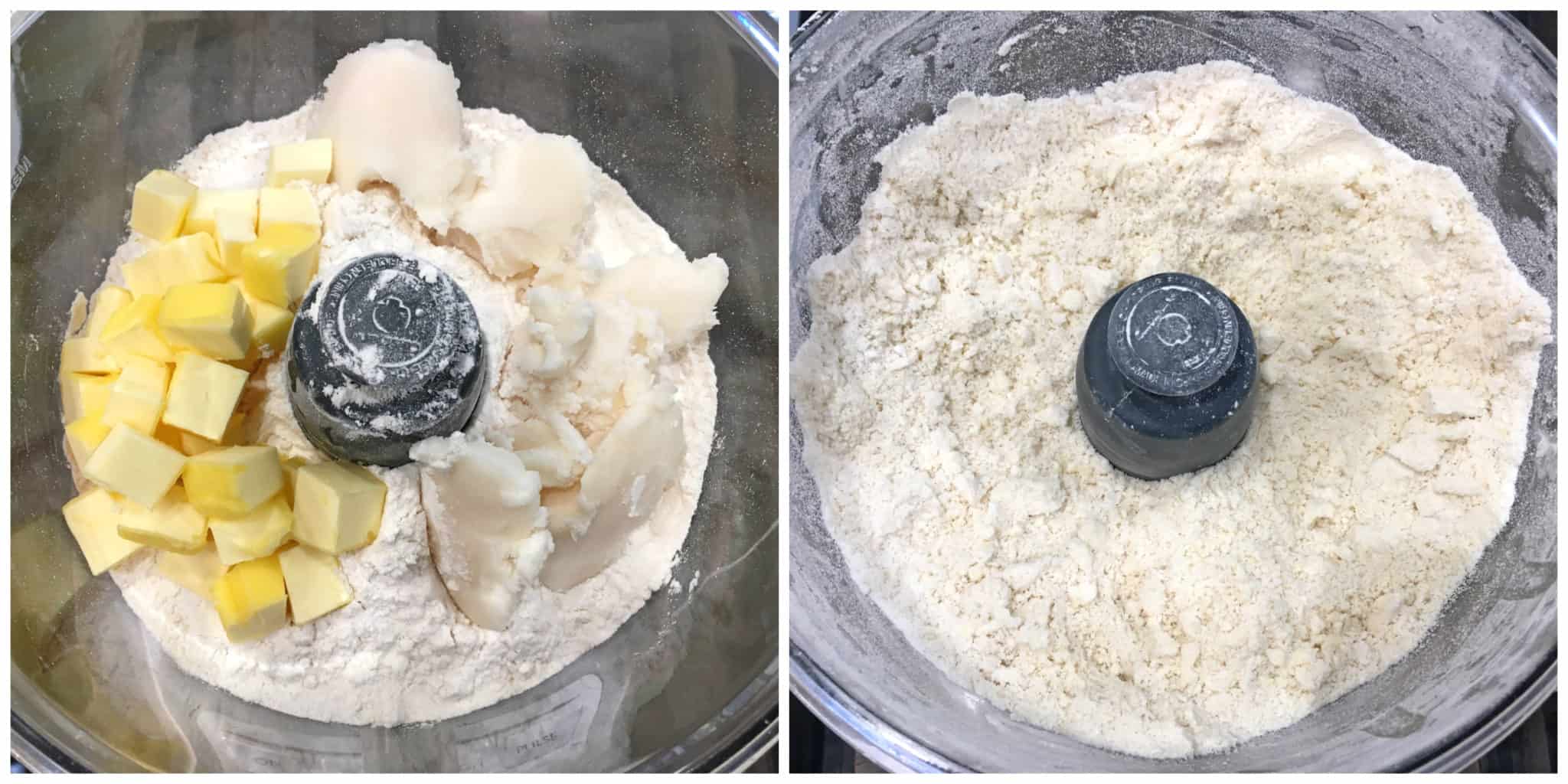
Add the water a little at a time, pulsing between additions, until the mixture begins to come together. DO NOT over-mix the dough or the pastry crust will be tough and won’t be flaky.

Form the dough into a ball, flatten into a 1-inch thick disk, wrap in plastic wrap and refrigerate for at least 3 hours before using (this is crucial). (Can be refrigerated for a few days or frozen for up to 3 months.)
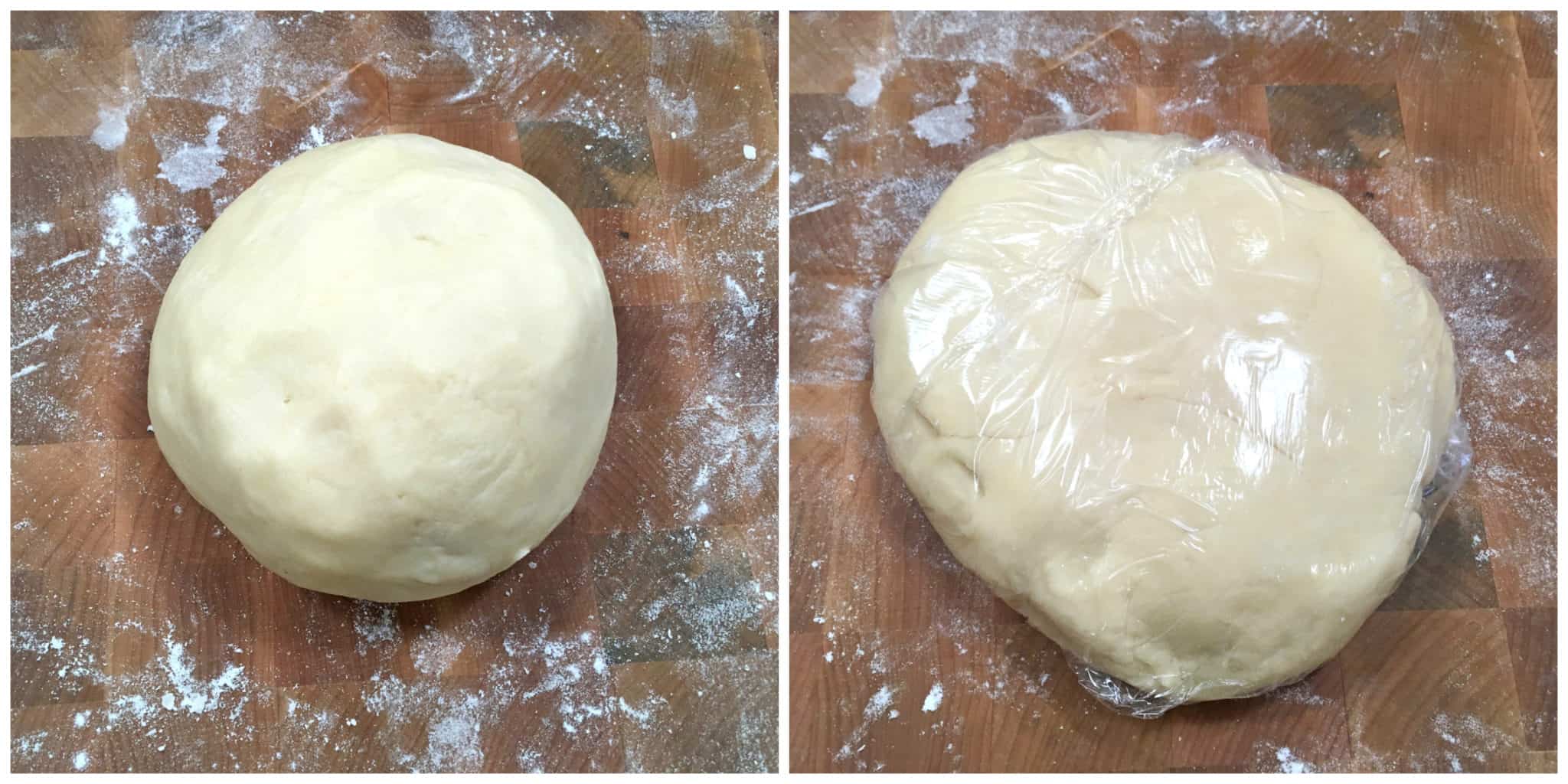
Roll the pastry dough into a log and cut it into 6 equal pieces.
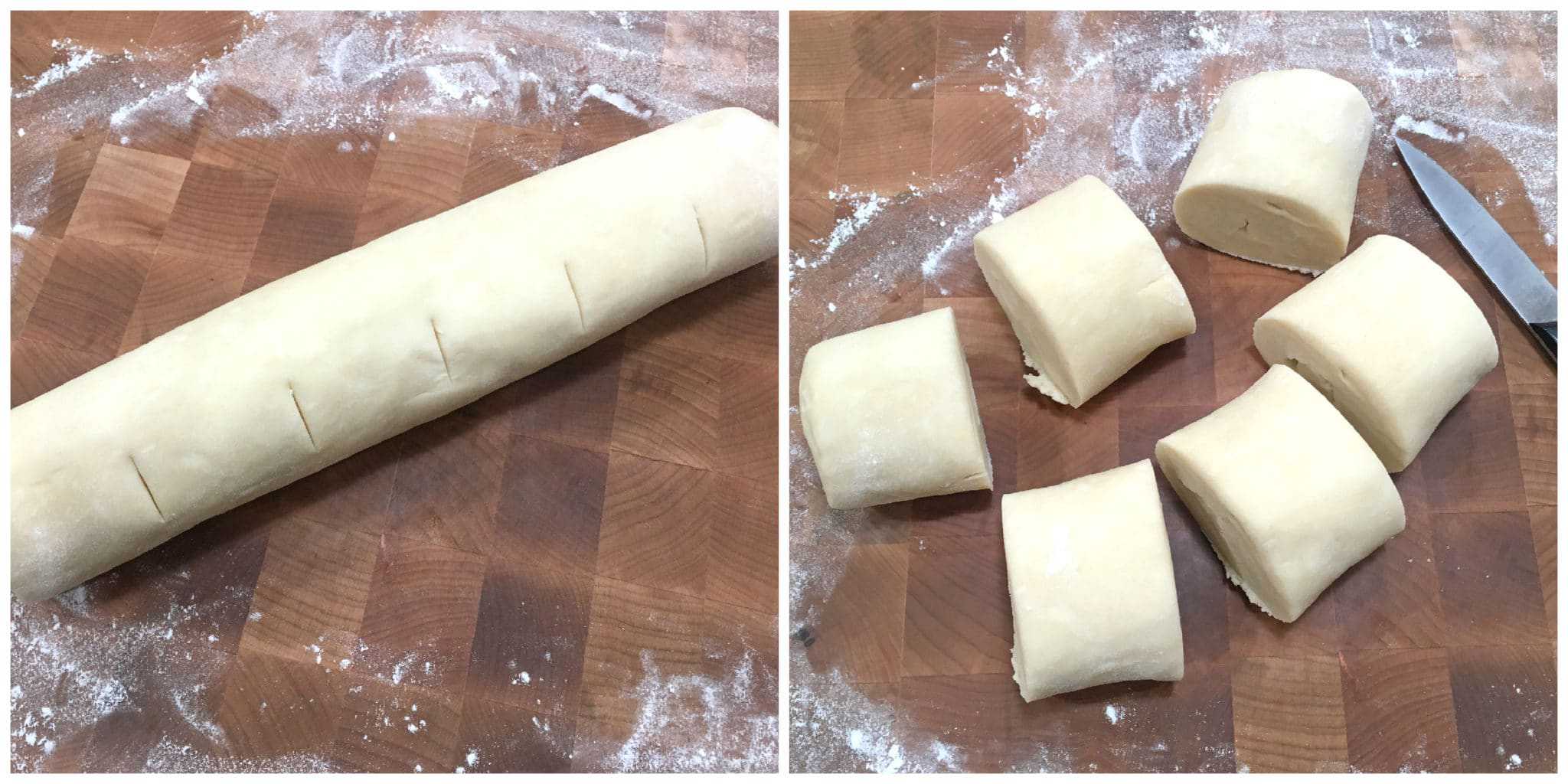
Wrap and keep the other 5 pieces chilled in the fridge while you’re working on one at a time. Roll the dough out on a lightly floured work surface to a 8 inch circle that’s about 1/8 inch thick. You can use an 8-inch plate as your guide and cut the dough around it to form your circle.

Layer the filling (each ingredient to be divided out between 6 pasties, there may be some excess remaining): Put layer of potatoes down the center of the pastry circle, leaving about 3/4 inch space on the top and bottom edges of the pastry dough. Lightly sprinkle with salt and pepper.
Next add a layer of rutabagas and sprinkle with salt and pepper.

Add a layer of beef followed by the onions and sprinkle with salt and pepper.

Lay a couple of pats of butter on top of the beef and sprinkle a little flour over the filling.

Wet the tips of your fingers and lightly moisten the edges of the pastry dough.
For the remaining steps work gently so that the filling doesn’t puncture through the dough. If this happens, patch up the hole with some of the scrap pieces of pastry dough. Bring the sides up and seal the pasty down the middle.

Turn the pasty onto its side and crimp/braid the edges in traditional Cornish fashion. This is the challenging part of making traditional Cornish pasties and takes some practice. There are some YouTube videos you can look up that show how to do this.


Assemble the remaining pasties and lay them on a lined baking sheet.
Use a sharp knife to cut a slit in the center of each pasty.

Lightly brush each pasty with the beaten egg mixture.
Bake the Cornish pasties on the middle rack for 40-50 minutes until golden in color. Remove from the oven and let them sit for about 10 minutes (they will be very hot inside) before eating.

The homemade Cornish pasties can be reheated in the oven or in microwave, but for a crispy crust I highly recommend reheating them in the oven.

Can Cornish Pasties Be Frozen?
Yes. The shortcrust pastry holds up well to freezing and thawing and the filling has little liquid which means the pasties won’t get soggy. You can freeze them either baked or unbaked, whichever you prefer. Wrap each pasty individually in plastic wrap and then store the wrapped pasties in a heavy-duty freezer bag.
If you’re freezing them unbaked it’s best to cook them while frozen – don’t thaw them first. Baking time will take roughly 15-20 minutes longer.
If you’re freezing them already fully baked and cooled then you can simply reheat them in the oven (for a crispier crust) or in the microwave and you have a quick, ready-to-go meal.
Enjoy!
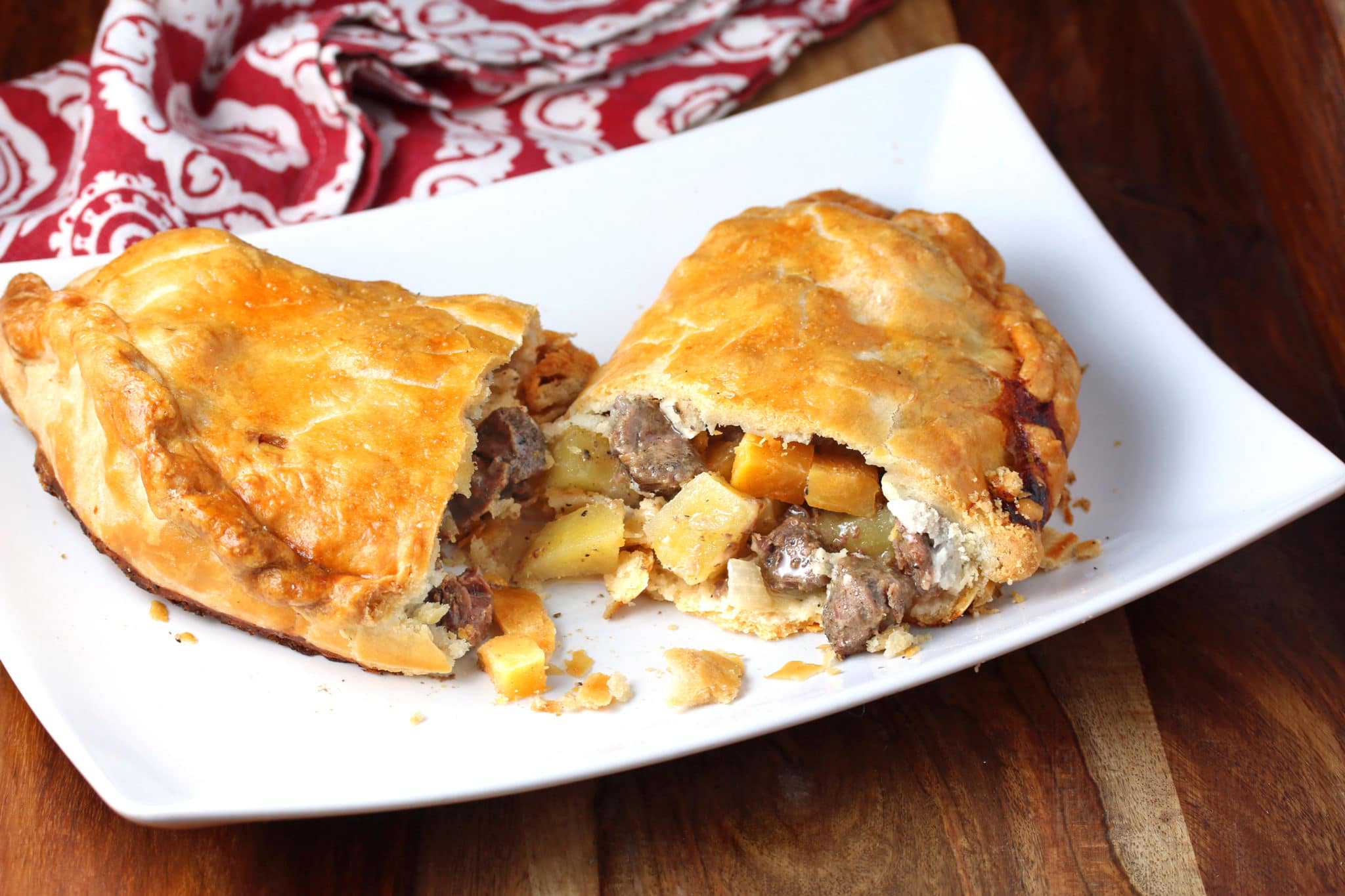
For more favorite British recipes try my:
- Fish and Chips
- Yorkshire Pudding
- Mushy Peas
- Bangers and Mash
- Scotch Eggs
- Crumpets
- Cornish Fairings
- Sticky Toffee Pudding
- Mincemeat Pie
- Beef and Guinness Stew
- Spotted Dick
- Chelsea Buns
- Toad in the Hole
- Eccles Cakes
- Scottish hortbread
- Treacle Tart
Save This Recipe
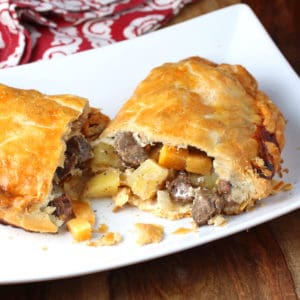
Authentic Cornish Pasty Recipe
Ingredients
For the Shortcrust Pastry:
- 3 1/2 cups all-purpose flour or bread flour (I make mine with all-purpose flour)
- 1 teaspoon salt
- 5 ounces unsalted butter , very cold, diced
- 5 ounces lard , very cold (can substitute butter but lard makes the flakiest crust)
- How to Render Lard (click link to learn how to make it yourself. It's super easy and much cheaper than store-bought!)
- 2/3 cup ice cold water
For the Cornish Pasties:
- 1 pound beef skirt steak or sirloin , cut into small cubes
- 1 pound firm, waxy potato (e.g. Yukon Gold) , peeled and diced in 1/4 inch cubes, or slice them according to personal preference (**starchy potatoes will disintegrate and turn mushy so be sure to use a firm, waxy potato that will hold its shape)
- 8 ounces rutabaga , peeled and diced in 1/4 inch cubes, or slice them according to personal preference
- 7 ounces yellow onion , chopped
- salt and pepper to taste
- unsalted butter (for cutting in slices to lay inside the pasties)
- all-purpose flour (for sprinkling inside the pasties)
- 1 large egg , lightly beaten
Instructions
- To Make the Shortcrust Pastry: Place the flour and salt in a food processor and pulse a few times until combined. Add the cold butter and lard and pulse a few more times until the mixture resembles coarse crumbs. Add the water a little at a time, pulsing between additions, until the mixture begins to come together. DO NOT over-mix the dough or the pastry crust will be tough and won't be flaky. Form the dough into a ball, wrap in plastic wrap, and refrigerate for at least 3 hours before using (this is crucial). (Can be refrigerated for a few days or frozen for up to 3 months.)
- To Make the Cornish Pasties: Preheat the oven to 350 degrees F.Cut it into 6 equal pieces (rolling the dough into a log and then cutting makes this easier). Wrap and keep the other 5 pieces chilled in the fridge while you're working on one at a time. Roll the dough out on a lightly floured work surface to a 8 inch circle that's about 1/8 inch thick. You can use an 8-inch plate as your guide and cut the dough around it to form your circle.
- Layer the filling (see note at end): Put layer of potatoes down the center of the pastry circle, leaving about 3/4 inch space on the top and bottom edges of the pastry dough. Lightly sprinkle with salt and pepper. Next add a layer of rutabagas, onions and finally the beef, adding a light sprinkling of salt and pepper between each layer. Lay a couple pats of butter on top of the beef and sprinkle a little flour over the filling.
- Wet the tips of your fingers and lightly moisten the edges of the pastry dough. For this next part work gently so that the filling doesn't puncture through the dough. If this happens, patch up the hole with some of the scrap pieces of pastry dough. Bring the sides up and seal the pasty down the middle. Turn the pasty onto its side and crimp the edges in traditional Cornish fashion (see blog post pictures as a visual).
- Assemble the remaining pasties and lay them on a lined baking sheet. Use a sharp knife to cut a slit in the center of each pasty. Lightly brush each pasty with the beaten egg mixture.
- Bake the Cornish pasties on the middle rack for 40-50 minutes until golden in color. Remove from the oven and let them sit for about 10 minutes (they will be very hot inside) before eating. They can be reheated in the oven (recommended for a crispier crust) or microwave. NOTE: Depending on how full you stuff the pasties you may have leftover filling. No worries, just fry it up together or add it to soup and enjoy it as a separate meal.
Nutrition
Originally published on The Daring Gourmet January 22, 2020



















Is the pastry for the pasties crisp like a cracker or flakey like a pie crust? I have agrandchild who cannot chew hard/cracker crunchty things. The recipe I have has the “cracker” crust. I am looking for something closer to melting in your mouth around the yummy filling.
Hi Shawna, it’s soft and flakey like pie crust. Happy baking! :)
Hi Shawna. Since these were primarily made for the coal miners, the crimped edge of the pasty were considered to be the “handle”. since the miners hands were usually dirty with coal dust, they would use the “handle” and discard it after consuming the rest of the pasty. The rest of the dough should be about like a flakey pie crust. Traditionally, you can put “yooper gravy” on them, aka (ketchup), or go for a beef gravy to not only add flavor, but also to soften the crust a bit.
Thanks for this recipe! I grew up in a small mining town in the UP of MI and every Thursday, the local Methodist church made these by the hundreds and delivered them to the schools and the mine (the cognoscenti among us knew to bring catsup to school on Thursdays-LOL). Despite us not being church folks, my Mom helped make ’em for years. It really chapped her hide that the preacher would come in scoop up a few to take home, even though neither he nor his wife could deign to help make them.
Anyhoo, (too much) skirt steak is on the menu tonight, so tomorrow the leftovers will be turned into pasties. Gotta run to the store now to get swedes. Fond memories!
Thanks again!
Ah, what a great story and memories, Bill, thanks so much for sharing! Happy baking and I hope you enjoy these and the trip down memory lane! <3
Brilliant recipe
Thank YOU* so much
Greatly appreciated. 🙂
Thank you, Dave, I’m so glad you enjoyed them!
Made these tonight and they were delicious. Want to freeze the extras for my daughter in law, who is from England. Should I thaw pre-baked pasties before reheating? And how long should I reheat at 350?
Thank you, Lisa, I’m glad you enjoyed them! You can do either but it’s generally recommended to reheat pastries straight from frozen – no thawing. At 350 you’ll want to aim for around 40 minutes or until the internal temp is 160 F.
so uh. I don’t remember asking for your vacation photos, or whatever this is. I want the recipe. PLEASE JUST GIVE THE RECIPE INSTRUCTIONS AND THE ingridients. if you want to post the history use wikipedia, if you want to post the photos then use your insta gram. We do not need your vacation photos. please god can we all stop posting recipes that have an entire lifes story worth of worthless info and pictures.
I don’t remember asking for your permission, Rob. Evidently you didn’t notice that is a personal food blog, not a sterile corporate-owned recipe site. Nevertheless, I’ve provided a convenient “Jump To Recipe” button at the very top of my blog posts for those who want to skip straight to the recipe. But if having to read a bit of history (heaven forbid) and viewing photos is too much for your brain to handle, and if clicking a button to skip straight to the recipe is just too much effort in order to get a FREE recipe, well then there’s not much hope for you, my friend. I would suggest buying cookbooks instead. But then, those often come with travel photos, life stories, and worthless info as well. Dang it.
Others may just want to stuff their face. I, for one, appreciate knowing the history of what I am making/eating. Thanks!
Thank you, William :)
Well said, Kimberly! Rob appears to be a miserable person.
Rob why don’t you just piss off somewhere else. It’s a free recipe, made for people with an interest in cooking new things or in your case someone who can’t afford to buy cook books. Not sure why you think you are entitled enough to dictate to to a private author about how he presents his FREE recipe. Anyway.. piss off Rob, go play with traffic, check yourself you absolute bellend.
Who pissed in your cereal? What a nasty piece of work you must be to have a rant about a person’s blog with a free recipe, you really need to crawl back under your rock because nobody likes you. Chill out dude, life’s too short for your ridiculous and mean spirited nonsense.
I think that was extremely rude Rob. I loved the pictures and what part of “jump to recipe” don’t u get? Maybe instead of griping when someone goes out of their way to show u some MAGNIFICENT Photos, u may want to expand your horizons or at least follow the model “If you don’t have something nice to say, say nothing at all.”
Poor Rob.
You are so angry, sincerely hope you get help and find your lessons in happiness through showing appreciation and gratitude rather than attacking someone behind a keyboard.
How about just a “thank you” for something Kimberly has taken the time to document and share FOR FREE non the less – with everyone? Curious what have you done that’s so great that you feel you’ve earned the right to critique someone you don’t even know with such authority??
p.s. Kimberly, you’ve earned my utmost respect with your reply to this guy. 🫠👊🏼💥
Made this tonight. It was so much better than I imagined. Nice saltiness from the pastry. Also loved the flavour and texture of rutabaga. My partner, who is from the UK approved this.
Will definitely make it again.
Wonderful, Sayo, I’m so glad you both enjoyed them, thank you!
Thanks for the recipe! I’m planning on making a batch and freezing them as a gift to my Dad for Christmas. Can you advise how long and at what temperature you would reheat these in the oven coming from frozen?
Hi Alissa, you can freeze them either baked or unbaked, whichever you prefer. Wrap each pasty individually in plastic wrap and then store the wrapped pasties in a heavy-duty freezer bag. If you’re freezing them unbaked it’s best to cook them while frozen – don’t thaw them first. Baking time will take roughly 15-20 minutes longer. If you’re freezing them already fully baked and cooled then you can simply reheat them in the oven which will help “re-crisp” the crust.
Do they not have spices in the UK?? Was some sort of law passed?
The basic seasonings in the UK are simply salt and pepper which appear on every table, but we have quite a rich tradition of spicing stretching back to the age of exploration (we embrace Indian and South Asian spices). The Cornish pasty, while using simple seasonings of salt & pepper is traditionally quite heavily seasoned. So, it is fairly salty and VERY peppery. If making one, go heavy on the pepper, and I’d say to use white pepper instead of black pepper.
In my lifetime, white pepper (i.e., white pepper being hulled black peppercorn and spicier than black pepper) has been usurped by the new kid on the block, black pepper, here in the UK.
Why is the ingredients raw when assembly
Hi Josie, because everything is cooked when the pasties are baked.
Great tips and tricks. Thank you born and bred in Devon so it’s a traditional pasty in my house! 😀
What is considered a “WAXY” potato??
Hi Melissa, waxy potatoes are low in starch and high in moisture. You want a firm, “waxy” potato for this that will hold some shape (e.g., red potatoes, Yukon Gold) and won’t disintegrate into mush (Russets for example are non-waxy/high in starch).
It is not bad, but you must use strong bread flour and absolutely mix well. You are not making regular shortcrust pastry here, and you need the pastry to be a bit stronger and stretchy, not crumbly… Also, use slightly more lard to butter for a crisper outside crust. Use 50% fat in the flour, not 62%. The amount of fat here should be 225g, not 280g…Too much fat will make this too crumbly, especially if using regular flour too…
Use bread flour not all purpose and crimp on the side. Crimping the top is the Devon way.
In that case that isn’t a Cornish pasty then… this recipe is for cornish pasty….the only true pasty…. all others are poor imitations
Michigan disagrees.
Go, Yuppers!
Different flours absorb different amounts of liquid. Next time just slowly add a drop more water teaspoon by teaspooon until it holds together in a soft but not sticky dough.
I followed the pastry instructions exactly and weighed all ingredients, but my dough was no where near as supple as what the dough pictured. It wasn’t dry, but just kept cracking and crumbling. Pies fell apart completely in the oven. I could barely get six 7-inch circles, let alone have anything to trim. I’m pretty comfortable with pie crust, but this was a challenge. I may try again subbing a hot water short crust dough.
nk, perhaps your pastry result might have been influenced not just by water content, but by the equipment used to make the dough. I’ve never made shortcrust pastry in my life before doing this wonderful recipe just two days ago, and my only swap (after obtaining “permission” from the author) was to swap the lard and use butter for ALL the fat. What truly AMAZED me, however, was that reheating the pasties in the oven made the crust even flakier and MORE delicious.
And, for those on tight schedules, I can report that my very first adventure with our Breville Food Processor’s dicing kit was little short of miraculous (especially for a guy who’s 76 and very much a “paint by number” cook!
Next adventure will be freezing after assembly, then baking from frozen, because the reason for taking on this challenge now is to have something delicious to contribute to next week’s Bozeman, MT pot luck “Burns Night Supper.” I spent 10 days in Scotland last summer, and while my more adventurous son missed no opportunity to try Haggis, I just could not bring myself to stomach something where one of the main ingredients IS (sheep’s) stomach!
Thanks so much for jumping in with that feedback, Jim! As per our email correspondence, I’m so glad these were a success and all the best on your upcoming “Burns Night” potluck! Kind regards, Kimberly
TWO things went wrong on my “game-day” baking. First, the crust was far less supple (and cracked repeatedly) even though I THINK I used precisely the same ratios of ingredients, water temperature, and even the number of pulses on the Breville. (Of course, that gives me the right to try again). The second was that I remembered correctly that we didn’t have the venue reserved for Bobby Burns’s ACTUAL birthday, meaning that we showed up two days before the gathering, my wounded-warrior pasties didn’t get exposed to public rebuke, and now are being defrosted one by one for personal consumption.
THREE pasty kitchen crusades in less than two weeks were just too much, however, so I followed my sister’s recommendation for another Scottish favorite: “Rumbledethumps.” At the end of the evening’s pot luck, my donated bottle of Glenfiddich 15 and my baking pan-full of rumbledethumps were both home runs (perhaps “one wee dram” left in the bottle. The Haggis was saluted with an IMPRESSIVE reading by the host of Rabbi’s “address to” poem, but was treated timidly by the gathered crowd (including me).
Aw Jim, I know you worked hard to prepare for that big night! And to have your trial run of a recipe be a success only to have something go wrong for the “real” round is just maddening. Rumbledethumps was a great call – much simpler and perfect comfort food. Haha, so did you end up sampling some haggis after all?? :)